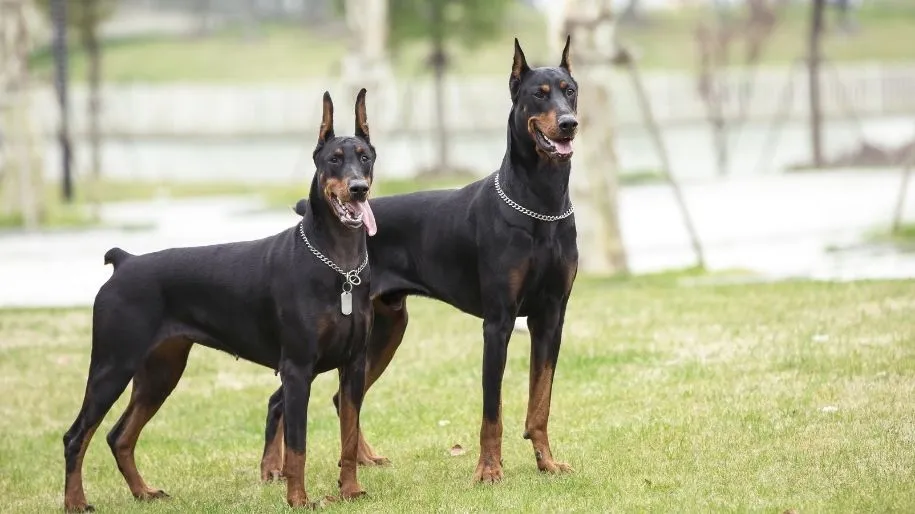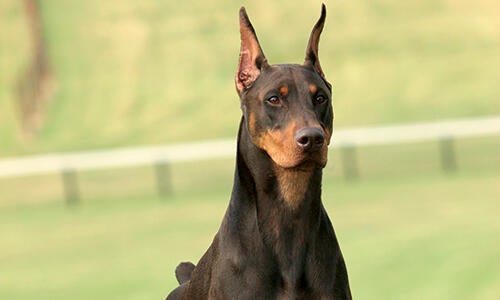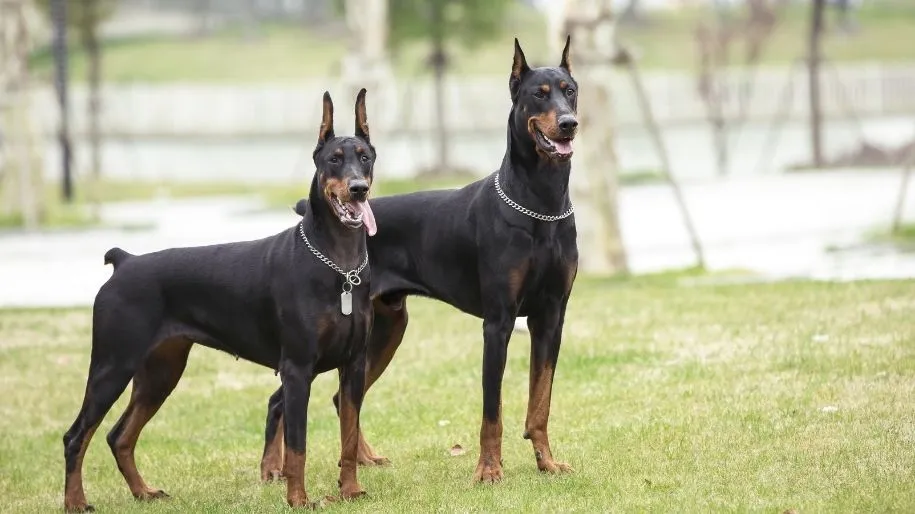Over the years, Doberman Pinschers have experienced a significant shift in their reputation and popularity as a breed. Once known primarily for their guarding abilities and fierce appearance, these dogs have now become beloved family pets and loyal companions.
This transformation can be attributed to a combination of factors. Firstly, increased education and awareness about proper training and socialization have helped dispel misconceptions about the breed’s temperament. Additionally, breeders have focused on breeding Dobermans with more balanced and stable personalities, resulting in dogs that are not only protective but also friendly and gentle with their families. As a result, Doberman Pinschers have become sought after as adaptable pets that can excel in various roles, such as search and rescue, therapy work, and competitive dog sports.
The Doberman Pinscher breed has evolved over the years to become more docile and friendly. Originally bred as guard dogs, they were known for their protective nature. However, through careful breeding and training, their temperament has been modified to be more family-friendly. This transition has made them great companions and family pets, while still retaining their alertness and loyalty. The changes in the breed’s characteristics have resulted in a more well-rounded and adaptable Doberman Pinscher.

What Happened to Doberman Pinschers?
The Doberman Pinscher is a well-known breed of dog that is known for its loyalty, intelligence, and protective nature. But what happened to Doberman Pinschers? Over the years, this breed has undergone changes in terms of temperament, appearance, and even health. In this article, we will explore the evolution of Doberman Pinschers and the factors that have influenced their transformation.
The Origins of Doberman Pinschers
Doberman Pinschers were originally developed in the late 19th century by a German tax collector named Karl Friedrich Louis Dobermann. Dobermann wanted a loyal and protective dog to accompany him during his rounds as a tax collector. He began the process of creating this breed by crossing several existing breeds, including the Rottweiler, German Pinscher, and Greyhound.
The result was a dog that had the loyalty and protective instincts of a Rottweiler, the agility and speed of a Greyhound, and the sleek appearance of a German Pinscher. These dogs were initially used as guard dogs and were known for their fearlessness and ability to protect their owners.
However, their aggressive nature made them unsuitable for many families, and the breed went through a period of decline. To address these issues, breeders began focusing on temperamental improvements and started breeding for a more balanced and stable temperament.
Temperament Changes
One of the most significant changes that happened to Doberman Pinschers is the shift in their temperament. Early Dobermans were known to be highly aggressive and protective, sometimes even to the point of becoming uncontrollable. This led to concerns about their suitability as family pets.
To address these concerns, breeders focused on selectively breeding Dobermans with a more stable and trainable temperament. Through careful breeding programs and temperament testing, they were able to produce Dobermans with a calmer and more predictable disposition.
Today, Doberman Pinschers are known for their loyalty, intelligence, and trainability. They are still protective of their families, but their aggressive tendencies have been significantly reduced. This makes them a more suitable breed for families and individuals looking for a loyal and obedient companion.
Appearance Changes
Another significant change that happened to Doberman Pinschers is their appearance. Early Dobermans had a more natural, undocked tail, and their ears were not traditionally cropped. However, over time, these cosmetic alterations became more popular among breeders and owners.
The practice of tail docking, which involves surgically removing a portion of the tail, became more prevalent to create the distinctive docked tail look that is commonly associated with Dobermans. Ear cropping, which involves removing a portion of the ear to create an upright pointed look, also became a standard practice.
However, these practices have become controversial in recent years, and many countries have banned or restricted tail docking and ear cropping. As a result, there has been a shift in the appearance of Doberman Pinschers, with many individuals now having natural, undocked tails and uncropped ears.
Health Concerns
Like many dog breeds, Doberman Pinschers are prone to certain health issues. One of the significant health concerns that have affected Dobermans is a genetic condition called dilated cardiomyopathy (DCM), which affects the heart’s ability to pump blood effectively.
Breeders have worked to identify and minimize the risk of DCM by conducting thorough health screenings and genetic testing. Responsible breeders focus on producing Dobermans with healthy hearts and work to eliminate DCM from their breeding lines.
Another common health issue in Doberman Pinschers is von Willebrand’s disease, a blood-clotting disorder. Through genetic testing, breeders can identify carriers of the disease and make informed breeding decisions to reduce the risk of von Willebrand’s disease in future generations.
Overall, the breed’s health has improved over the years due to the efforts of responsible breeders who prioritize health testing and selective breeding.
The Future of Doberman Pinschers
The Doberman Pinscher has come a long way since its origin as a tax collector’s loyal companion. The breed has evolved in terms of temperament, appearance, and health. As responsible breeding practices continue to prioritize the well-being and betterment of the breed, the future of Doberman Pinschers looks promising.
Today, Dobermans are cherished as loving family pets, devoted working dogs, and loyal companions. Their intelligence, trainability, and protective nature make them a popular choice for various roles, including service dogs, search and rescue dogs, and therapy dogs.
Whether you admire the Doberman’s sleek appearance, appreciate their loyalty and protective instincts, or value their intelligence and trainability, one thing is clear: the Doberman Pinscher continues to captivate our hearts and remains an iconic breed in the canine world.
Key Takeaways: What Happened to Doberman Pinschers?
1. Doberman Pinschers were originally bred for personal protection, but their aggressive reputation is largely a misconception.
2. The breed’s popularity declined in the mid-20th century due to negative media portrayal and mismanagement by some breeders.
3. Responsible breeding practices and education have helped improve the reputation and overall health of Doberman Pinschers.
4. The breed is now known for its loyalty, intelligence, and versatility in various dog sports.
5. Doberman Pinschers still face some health concerns, but responsible ownership and proper healthcare can help mitigate these issues.
Frequently Asked Questions
The following are some common questions related to the topic of what happened to Doberman Pinschers:
1. Are Doberman Pinschers an endangered breed?
Doberman Pinschers are not considered an endangered breed. While their popularity has fluctuated over the years, they remain a well-established breed within the dog community. However, like any breed, it is important to support responsible breeding practices to ensure the long-term health and welfare of Doberman Pinschers.
Doberman Pinschers are known for their loyalty, intelligence, and protective nature. They have served in various roles, including as police and military dogs, search and rescue dogs, and therapy dogs. While their numbers may have decreased in some areas, they continue to be cherished and valued by many dog enthusiasts.
2. Why did the popularity of Doberman Pinschers decline in the past?
The popularity of Doberman Pinschers has experienced fluctuations over the years. In the past, their reputation as guard dogs and their association with aggressive behavior led to some negative misconceptions about the breed. This perception, combined with inadequate training and responsible ownership, contributed to a decline in their popularity.
However, responsible breeders and educated dog owners have worked to dispel these misconceptions and promote the true nature of Doberman Pinschers as intelligent, loyal, and trainable companions. As a result, their popularity has seen an upward trend in recent years, especially among individuals who appreciate their unique qualities and are committed to providing them with proper care and training.
3. Have there been any health issues affecting Doberman Pinschers?
Like many dog breeds, Doberman Pinschers are susceptible to certain health conditions. One notable concern is the risk of dilated cardiomyopathy (DCM), a heart disease that can affect Dobermans. It is important for Doberman owners to be aware of this potential health issue and work closely with their veterinarians to monitor their dog’s heart health.
Additionally, Doberman Pinschers may be prone to hip dysplasia, von Willebrand’s disease (a bleeding disorder), and hypothyroidism. Regular health check-ups, proper nutrition, exercise, and responsible breeding practices can help mitigate these health risks and ensure the well-being of Doberman Pinschers.
4. Are Doberman Pinschers good family pets?
Doberman Pinschers can make excellent family pets when properly trained, socialized, and given plenty of love and attention. They are known for their loyalty and protective instincts, making them excellent companions for families who are looking for a devoted and watchful dog.
However, it is important to note that Dobermans are a high-energy breed that requires regular exercise and mental stimulation. They thrive in environments where they have a job to do and a structured routine. Families considering a Doberman Pinscher as a pet should be prepared to provide them with the exercise, training, and socialization they need to thrive.
5. How can I find a reputable Doberman Pinscher breeder?
Finding a reputable Doberman Pinscher breeder is essential to ensure you are getting a healthy and well-bred puppy. Here are a few tips to help you find a reputable breeder:
– Research: Start by doing thorough research about Doberman Pinschers and the breed standards. This will help you identify reputable breeders who prioritize health and temperament.
– Referrals: Seek recommendations from local breed clubs, veterinarians, or trusted dog owners who have experience with Doberman Pinschers. They may be able to refer you to reputable breeders in your area.
– Visit the Breeder: Once you have found potential breeders, schedule a visit to their facilities. Observe the living conditions of the dogs, meet the breeding adults, and assess the breeder’s knowledge and commitment to the breed.
– Health Testing: Reputable breeders will conduct health screenings on their breeding dogs to minimize the risk of passing on genetic diseases. Ask the breeder for documentation of health testing.
– Contract: A reputable breeder will provide a written contract that outlines their responsibilities, health guarantees, and support for the puppy. Read the contract carefully and ask any necessary questions before making a commitment.

10 Reasons Why Doberman Pinschers Make the Perfect Family Pet
In recent years, Doberman Pinschers have experienced a decline in popularity as family pets. This is mainly due to misconceptions about their temperament and perceived aggression.
However, it’s important to note that Dobermans can make loyal and loving companions when properly trained and socialized. They are intelligent, protective, and energetic dogs that thrive in active households with dedicated owners.
